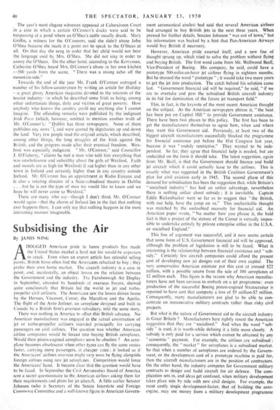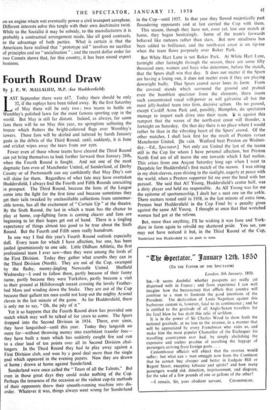Subsidising the Air
By JAMES WING
ADOGGED American pride in home products has made the United States market a hard nut for would-be exporters to crack. Even when an export article has splendid selling points, British firms often find the Americans reluctant to buy ; they prefer their own home market. The aircraft industry is a case in point, and, incidentally, an object lesson on the relation between the Government and the industry. The Farnborough Air Display in September, attended by hundreds of overseas buyers, showed quite conclusively that Britain led the world in jet and turbo- propeller civil airliners. The Americans saw the lesson driven home by the Hermes, Viscount, Comet, the Marathon and the Apollo. The flight of the Avro Jetliner, an aeroplane designed and built in Canada by a British firm's,overseas subsidiary, told the same story.
There was nothing in America to offset this British advance. No American manufacturer was engaged in the actual construction of jet or turbo-propeller airliners intended principally for carrying passengers on civil airlines. The question was whether American airline companies would be forced into buying British aeroplanes. Would their piston-engined aeroplanes soon be obsolete ? An aero- plane becomes obsolescent when other types can fly the same routes faster, carrying more passengers, at cheaper rates ; it looked as if the Americans' airlines overseas might very soon be flying alongside foreign airlines using new jet aeroplanes. Competition would force the Americans' hand. It became clear that the question would have to be faced. In September the Civil Aeronautics Board of America sent a secret questionnaire to the American airlines asking them for their requirements and plans for jet aircraft. A little earlier Senator Johnson (who is Secretary of the Senate Interstate and Foreign Commerce Committee and a well-known figure in American Govern-
ment aeronautical circles) had said that several American airlines had arranged to buy British jets in the next three years, - When pressed for further details, Senator Johnson "was out of town," but his information was backed by a hint that Pan-American Airways would buy British if necessary.
However, American pride asserted itself, and a new line of thought sprang up, which tried to solve the problem without flying and buying British. The first word came from Mr. Wellwood Beall, Vice-President of Boeing. His company, he said, could have a prototype 500-miles-an-hour jet airliner flying in eighteen months. But he stressed the word " prototype " ; it would take two more years to get the jet into production. The catch behind his solution came last. "Government financial aid will be required," he said, "if we are to overtake and pass the subsidised British aircraft industry in its bid for domination of the future jet transport field."
This, in fact, is the keynote of the most recent American thought on the subject. As the American newspapers phrase it, "the heat , has been put on Capitol Hill" to provide Government assistance. There have been two phases to this policy. The first has been to get the manufacturers themselves to agree how, when and where they want this Government aid. Previously, at least two of the biggest aircraft manufacturers successfully blocked the programme for financial assistance put before the 81st Congress last year, because it was "unduly restrictive." They wanted to be inde- pendent. So far, they agree that financial help is needed, but are undecided on the form it should take. The latest suggestion, again from Mr. Beall, is that the Government should finance and build jet aircraft which it could actually lease to the airlines. This is exactly what was suggested in the British Coalition Government's plan for civil aviation early in 1945. The second phase of this demand for subsidisation has been the suggestion that, while Britain's "socialised industry" has had an unfair advantage, nevertheless there is nothing unfair about subsidy ; it is inevitable. Captain Eddie Rickenbacker went so far as to suggest that "the British, with our help, have the jump on us." This uncharitable thought was matched by the undoubted necessity for financial aid. An American paper wrote, "No matter how you phrase it, the bald fact is that a project of the stature of the Comet is virtually impos- sible to undertake entirely by private enterprise either in the U.S.A. or socialised England."
This line of argument was successful, and it now seems certain that some form of U.S. Government financial aid will be approved, although the problem of legislation is still to be faced. What is interesting is the relationship between financial assistance and "sub- sidy." Certainly few aircraft companies could afford the present cost of developing new jet designs out of their own capital. The very conservative American estimate put this cost at around $22 million, with a possible return from the sale of 100 aeroplanes at $2 million each. This figure is the reason why American manufac- turers have not been anxious to embark on a jet programme: even production of the successful Boeing piston-engined Stratocruiser is reported to have cost that company a loss of $5 million-$7 million. Consequently, many manufacturers are glad to be able to con- centrate on remunerative military contracts rather than risky civil projects.
But what is the nature of Government aid to the aircraft industry in Great Britain ? Manufacturers here rightly resent the American suggestion that they are "socialised." And when the word " sub- sidy " is used, it is worth-while defining it a little more closely. A subsidy is only paid for a service which cannot be obtained by any " economic " payment. For example, the airlines are subsidised ; consequently, the " market " for aeroplanes is a subsidised market. So that when a number of aeroplanes are ordered by the Govern- ment, or the development cost of a prototype machine is paid for, then the aircraft manufacturers are in the position of contractors. On the other hand, the industry competes for Government military contracts to design and build aircraft for air defence. The com- plication sets in, and ideas get confused, when military development takes place side by side with new civil designs. For example, the most costly single development-factor, that of building the aero- engine, may use money from a military development programme on an engine which will eventually power a civil transport aeroplane. Different interests solve this tangle with their own doctrinaire twist. While to the Socialist it may be subsidy, to the manufacturers it is probably a contractual arrangement made, like all good contracts, to the advantage of both parties. What is certain is that the Americans have realised that "prototype aid" involves no sacrifice of principles and no " socialisation" ; and the recent dollar order for two Comets shows that, for this country, it has been sound export business.































 Previous page
Previous page